It’s early morning on an overcast and slightly breezy Wednesday in early May. The clouds look indecisive and the wind isn’t enough to be dangerous, just enough to make you wear a hoodie or a jacket. Today is the day I get my initiation, a glimpse into a day in the life of an Arborist.
Here’s some of what I learned.
Your lawn will (probably) be damaged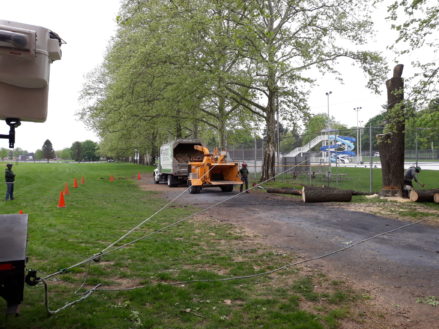
There are many factors that go into this. The most common concern clients have is about the equipment moving around on their lawn. This is a completely valid concern.
There may be times your tree pruning company tells you they cannot service your property. For example, after a rain, you wouldn’t want heavy equipment on the lawn. The summer dry spells or frozen ground in the winter are great times to have your service completed; you don’t have to worry about this quite as much.
There are things some companies do to try and offset this damage, like using plywood where the bucket truck needs to drive across the lawn. Depending on the distance the truck needs to move, this might be impractical or unnecessary.
Another consideration when it comes to lawn damage is from the pruning or removal process itself. Trained and certified Arborists will often use pulleys (called “blocks”) to tie-off limbs and control the direction the limbs fall. Depending on the size of the limbs being removed, trying to lower the limb is likely just dangerous.
As it is, on the day I was out, we didn’t have to worry about damage to the ground from the truck; there was a gravel path next to the tree we were removing. We did still have to worry about falling limbs, however. At one point, the impact of a limb hitting the ground on that gravel path sent a quarter-sized rock flying 30 feet across the jobsite (I was well out of the way) and hit me. That type of weight hitting turf is still (probably) going to cause damage.
That brings me to my next point…
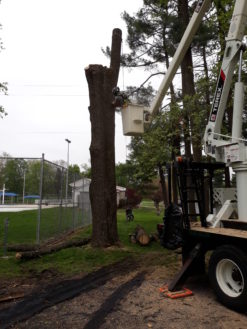 It’s dangerous
It’s dangerous
That limb I just described probably weighed a couple hundred pounds. It doesn’t take a genius to realize that this limb falling on you would really ruin your day.
According to the Occupational Health and Safety Administration (OSHA), there were 45 accidents related to “tree trimming” nationwide, or one every 8 days. Of those incidents, 35 of them involved a fatality.
Those are just the reported injuries and deaths. OSHA only requires reporting for Tree companies if there’s a death, hospitalization, loss of eye, or amputation. As a result, other accidents undoubtedly happened that went unreported. This doesn’t include homeowners who were injured or killed trying to prune a tree by themselves.
None of this mentions the personal protective equipment (PPE) that you should be wearing, which includes a hard hat, safety glasses, gloves, and long sleeves. On this day, I was wearing a hooded sweatshirt, and I had to tuck the strings into the sweatshirt, making sure they didn’t get caught on anything. The regular Arborists out on the job wearing sweatshirts had removed those strings altogether.
Then there’s the chipper. This machine literally grabs limbs and feeds them into a giant grinding wheel, and shoots the debris into the back of a truck. At one point, I was nearly injured when the chipper grabbed a limb and it turned sideways, bringing up part of the branch and almost hitting me in the face.
This is why we always recommend you allow a professional to service the trees on your property. Owning a chainsaw does not necessarily make a person qualified to prune or drop a tree.
A working knowledge of Physics is critical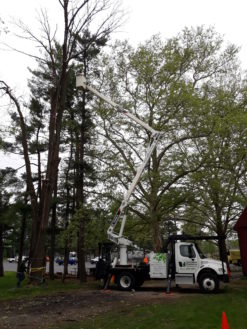
You can translate this as “experience” if you like.
Basically, when you’ve got someone 50 feet in the air in a bucket or tied-in to a tree with a harness, that’s dangerous enough.
Now add a chainsaw.
Now factor in that there will be limbs falling to the ground from that point.
If that person doesn’t understand where to cut, several bad things can happen. As a best-case scenario, they will get the bar (“blade”) of the chainsaw pinched between parts of the branch they’re cutting, and unable to move it.
A scarier scenario is the limb falls where it damages property.
Worst-case is someone is injured or killed.
During my day out with our Tree Pruning crew, I watched that guy (it happened to be a guy in this case) with the chainsaw 50 feet in the air consistently drop limbs in places where no one was close. He was conscientious of where the limb was falling, and more conscientious of where the people on the ground were.
Also, this takedown happened to be next to a chain link fence (no more than 15 feet from the tree trunk). It was pretty impressive that the entire day, a single branch fell and hit that fence, with no property damage.
It’s exhausting
I’m actually a fairly fit individual. Well, I’d like to think I’m more fit than most people, anyway. I run about 10-11 miles a week, lift heavy weight, and kayak and bike for recreation. I’m not necessarily a couch potato.
I was tired at the end of the day. Like, really tired.
This job is physically taxing. That “small” 20-foot tree you are thinking about taking down yourself is going to kill your whole weekend, my friend. Especially if you’re doing it by yourself. Come Monday, you’ll wish you had another weekend to recover.
There’s hauling large limbs and chunks of the trunk around until you get them where you want them. Then you have to clean up the smaller limbs and branches. You have to rake a TON (you won’t realize until you’re knee-deep in the project – trust me). For example, I heard one Arborist joke to another “I had a client ask me about a takedown like this. I told him it was $1,000, but if I don’t have to rake, it’s eight bucks!”
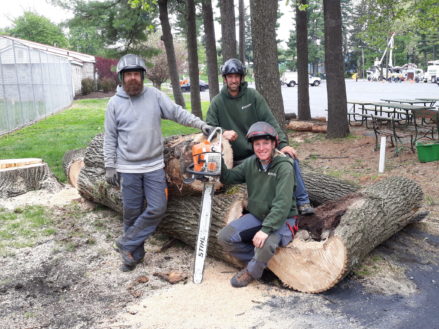 Conclusion
Conclusion
As a homeowner, you have a lot to worry about. There are always considerations you have to make in terms of balancing the “Do It Myself” versus “Hire A Professional.” For a job on this scale, please take the time to hire a real professional.
Check reviews, check to make sure they have insurance, check to see the company is a member of any relevant industry associations, check to see if there are Certified Arborists on staff. Don’t compromise on safety or quality in this area.
If you’d like to talk more about our services, you can Contact Us here.
The post A Day in the Life of an Arborist appeared first on Tomlinson Bomberger.
from Tomlinson Bomberger http://bit.ly/2WNnhux
 Congratulations to GardenRanter Scott Beuerlein for winning not one but TWO Silver Writing Awards from GardenComm (formerly Garden Writers Association).
Congratulations to GardenRanter Scott Beuerlein for winning not one but TWO Silver Writing Awards from GardenComm (formerly Garden Writers Association).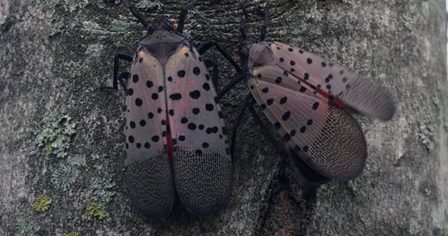 What is the Spotted Lanternfly?
What is the Spotted Lanternfly?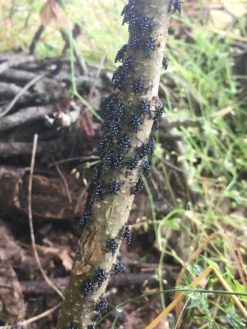 Right now, you might see them anywhere. Adults lay their eggs on just about anything. We’ve had clients reporting nymphs on decks, potted plants, and patios. You will see these nymphs feeding near where the leaves emerge from branches, or on very young trees. This is because they’re piercing-sucking mouth-parts aren’t well developed yet, and the bark is thinner on young plants and at the end of branches.
Right now, you might see them anywhere. Adults lay their eggs on just about anything. We’ve had clients reporting nymphs on decks, potted plants, and patios. You will see these nymphs feeding near where the leaves emerge from branches, or on very young trees. This is because they’re piercing-sucking mouth-parts aren’t well developed yet, and the bark is thinner on young plants and at the end of branches.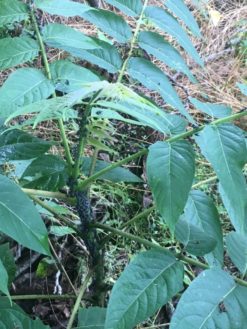 Tree Identification
Tree Identification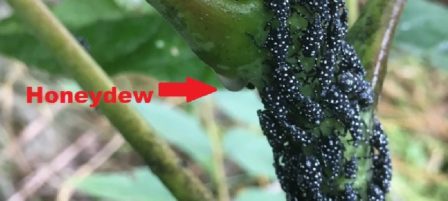 What a mess!
What a mess! “You can’t talk about conservation on one hand and development on the other as if they were two unrelated issues because they’re not.”—Tom Hoyt (who does both)
“You can’t talk about conservation on one hand and development on the other as if they were two unrelated issues because they’re not.”—Tom Hoyt (who does both) The High Plains Environmental Center maintains about 700 acres of wildlife habitat and public environmental park in the middle of the Centerra mixed-use community. There are trails, ponds, native plant demonstration gardens, wetlands, a fruit orchard, community garden raised beds, and a native plant nursery. Walking the trails, I was continually aware of birds, insects, and other creatures, with bees working away on the native shrubs I passed. There are dozens of species of birds living here, including kestrels, blue-winged teal, grebes, herons, American eagles, hawks, rails, sandpipers, owls, warblers, and many more, including these American white pelicans (above), which I had never seen before. You can get a complete plant and animal species list from the
The High Plains Environmental Center maintains about 700 acres of wildlife habitat and public environmental park in the middle of the Centerra mixed-use community. There are trails, ponds, native plant demonstration gardens, wetlands, a fruit orchard, community garden raised beds, and a native plant nursery. Walking the trails, I was continually aware of birds, insects, and other creatures, with bees working away on the native shrubs I passed. There are dozens of species of birds living here, including kestrels, blue-winged teal, grebes, herons, American eagles, hawks, rails, sandpipers, owls, warblers, and many more, including these American white pelicans (above), which I had never seen before. You can get a complete plant and animal species list from the  There are other such communities throughout the US—sadly, this movement has not come yet to Western New York, to my knowledge. This is a model where conservation can support itself; fees generated by building permits are paid to a nonprofit and a community that’s attractive to investors, residents, and businesses emerges. HPEC started as the idea of architect/builder Tom Hoyt (quoted above) who, with his company, McStain, signed an agreement with developers Centerra in 2001. It took 16 years to clean-up and restore the site. HPEC is now headed by Jim Holstrup, who spoked to the group of bloggers I was part of (the annual
There are other such communities throughout the US—sadly, this movement has not come yet to Western New York, to my knowledge. This is a model where conservation can support itself; fees generated by building permits are paid to a nonprofit and a community that’s attractive to investors, residents, and businesses emerges. HPEC started as the idea of architect/builder Tom Hoyt (quoted above) who, with his company, McStain, signed an agreement with developers Centerra in 2001. It took 16 years to clean-up and restore the site. HPEC is now headed by Jim Holstrup, who spoked to the group of bloggers I was part of (the annual 











 It’s dangerous
It’s dangerous
 Conclusion
Conclusion
